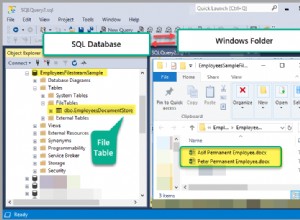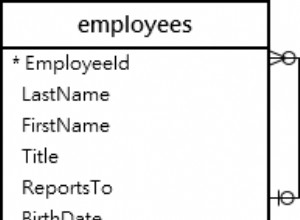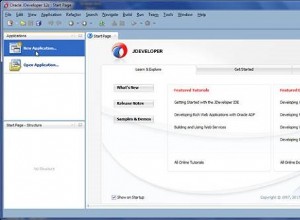Dopo aver fatto alcuni commenti forse irriverenti, questo problema mi è rimasto in testa per tutta la sera e alla fine ho escogitato il seguente approccio basato sul set. Credo che si qualifichi sicuramente come "elegante", ma penso anche che si qualifichi come "un po' stupido". Fai la chiamata.
Per prima cosa, imposta alcune tabelle:
-- For testing purposes
DROP TABLE Source
DROP TABLE Numbers
DROP TABLE Results
-- Add as many rows as need be processed--though note that you get N! (number of rows, factorial) results,
-- and that gets big fast. The Identity column must start at 1, or the algorithm will have to be adjusted.
-- Element could be more than char(1), though the algorithm would have to be adjusted again, and each element
-- must be the same length.
CREATE TABLE Source
(
SourceId int not null identity(1,1)
,Element char(1) not null
)
INSERT Source (Element) values ('A')
INSERT Source (Element) values ('B')
INSERT Source (Element) values ('C')
INSERT Source (Element) values ('D')
--INSERT Source (Element) values ('E')
--INSERT Source (Element) values ('F')
-- This is a standard Tally table (or "table of numbers")
-- It only needs to be as long as there are elements in table Source
CREATE TABLE Numbers (Number int not null)
INSERT Numbers (Number) values (1)
INSERT Numbers (Number) values (2)
INSERT Numbers (Number) values (3)
INSERT Numbers (Number) values (4)
INSERT Numbers (Number) values (5)
INSERT Numbers (Number) values (6)
INSERT Numbers (Number) values (7)
INSERT Numbers (Number) values (8)
INSERT Numbers (Number) values (9)
INSERT Numbers (Number) values (10)
-- Results are iteratively built here. This could be a temp table. An index on "Length" might make runs
-- faster for large sets. Combo must be at least as long as there are characters to be permuted.
CREATE TABLE Results
(
Combo varchar(10) not null
,Length int not null
)
Ecco la routine:
SET NOCOUNT on
DECLARE
@Loop int
,@MaxLoop int
-- How many elements there are to process
SELECT @MaxLoop = max(SourceId)
from Source
-- Initialize first value
TRUNCATE TABLE Results
INSERT Results (Combo, Length)
select Element, 1
from Source
where SourceId = 1
SET @Loop = 2
-- Iterate to add each element after the first
WHILE @Loop <= @MaxLoop
BEGIN
-- See comments below. Note that the "distinct" remove duplicates, if a given value
-- is to be included more than once
INSERT Results (Combo, Length)
select distinct
left(re.Combo, @Loop - nm.Number)
+ so.Element
+ right(re.Combo, nm.Number - 1)
,@Loop
from Results re
inner join Numbers nm
on nm.Number <= @Loop
inner join Source so
on so.SourceId = @Loop
where re.Length = @Loop - 1
-- For performance, add this in if sets will be large
--DELETE Results
-- where Length <> @Loop
SET @Loop = @Loop + 1
END
-- Show results
SELECT *
from Results
where Length = @MaxLoop
order by Combo
L'idea generale è:quando si aggiunge un nuovo elemento (ad esempio "B") a qualsiasi stringa (ad esempio "A"), per catturare tutte le permutazioni si dovrebbe aggiungere B a tutte le posizioni possibili (Ba, aB), risultando in un nuovo insieme di stringhe. Quindi itera:aggiungi un nuovo elemento (C) a ciascuna posizione in una stringa (AB diventa Cab, aCb, abC), per tutte le stringhe (Cba, bCa, baC) e hai l'insieme di permutazioni. Esegui l'iterazione su ogni set di risultati con il carattere successivo finché non esaurisci i personaggi... o le risorse. 10 elementi corrispondono a 3,6 milioni di permutazioni, circa 48 MB con l'algoritmo di cui sopra e 14 elementi (unici) raggiungerebbero 87 miliardi di permutazioni e 1,163 terabyte.
Sono sicuro che alla fine potrebbe essere incastrato in un CTE, ma alla fine tutto ciò che sarebbe è un ciclo glorificato. La logica è più chiara in questo modo e non posso fare a meno di pensare che il piano di esecuzione del CTE sarebbe un incubo.




